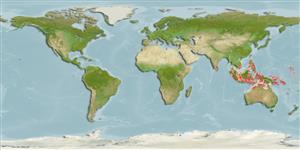>
Gobiiformes (Gobies) >
Gobiidae (Gobies) > Gobiinae
Etymology: Eviota: No etymology given, suggested by Christopher Scharpt: from Latin 'eu' for 'true' and 'iota' for anything very small, in combination 'truly very small' referring to it as being the smallest vertebrate at the time it has benn described by Jenkins (thus, making the suggestion by Scharpt plausible.; rubrisparsa: Name from Latin 'rubrum' for red and 'sparsus' or sprinkled, referring to the live color pattern of red dots..
More on authors: Greenfield & Randall.
Environment: milieu / climate zone / depth range / distribution range
Ecología
marino asociado a arrecife; rango de profundidad 20 - 28 m (Ref. 83982). Tropical
Indo-West Pacific: Christmas Island (Indian Ocean), Indonesia (Flores, Alor, West Papua), Papua New Guinea (D'Entrecasteaux Islands and New Britain), Solomon Islands.
Tamaño / Peso / Age
Maturity: Lm ? range ? - ? cm
Max length : 2.0 cm SL macho / no sexado; (Ref. 83982)
Short description
Morfología | Morfometría
Espinas dorsales (total): 7; Radios blandos dorsales (total): 9; Espinas anales 1; Radios blandos anales: 8. This species is distinguished from its congeners by the following set of characters: dorsal/anal fin-ray formula 9/8; pectoral fin rays 16-19 (mean 18), 5-6 lower rays branched; cephalic sensory-pore system pattern I (complete); fifth segmented pelvic-fin ray 11.5-22% of fourth; branches on fourth pelvic-fin ray 5-7, 3 segments between branches; non-fimbriate genital papilla; dorsal fin filamentous (to 36.9% SL); body with no distinct large dark marks; anal fin and lower half of caudal fin dark; scattered melanophores behind eyes on nape; when alive, small red dots cover the body but these disappear when preserved in ethyl alcohol (Ref. 83982); characterized further by longitudinal scale series 25; ctenoid scales, none on head, nape, breast and pectoral fin base; depth of body 4.7-5.6 in SL (Ref. 90102).
Inhabits sand-rubble bottoms among reefs in 4-15 m (Ref 90102).
Life cycle and mating behavior
Madurez | Reproducción | Puesta | Huevos | Fecundidad | Larva
Greenfield, D.W. and J.E. Randall, 2010. Four new gobiid fishes of the genus Eviota from the Western Pacific, with clarification of Evoita guttata and Evoita albolineata (Teleostei: Goblidae). Proc. Calif Acad. Sci. 61(3):269-289. (Ref. 83982)
IUCN Red List Status (Ref. 130435)
Threat to humans
Harmless
Human uses
Más información
Nombres comunesSinónimosMetabolismoDespredadoresEcotoxicologíaReproducciónMadurezPuestaAgregación para la puestaFecundidadHuevosEgg development
Age/SizeCrecimientoLength-weightLength-lengthLength-frequenciesMorfometríaMorfologíaLarvaDinámica larvariaReclutamientoAbundanciaBRUVS
ReferenciasAcuiculturaPerfil de acuiculturaRazasGenéticaElectrophoresesheritabilidadEnfermedadesProcesamientoNutrientsMass conversion
ColaboradoresImágenesStamps, Coins Misc.SonidosCiguateraVelocidadTipo de nataciónSuperficie branquialOtolitosCerebrosVisión
Herramientas
Special reports
Download XML
Fuentes de Internet
Estimates based on models
Preferred temperature (Ref.
123201): 27.2 - 28.3, mean 28 °C (based on 7 cells).
Phylogenetic diversity index (Ref.
82804): PD
50 = 0.5000 [Uniqueness, from 0.5 = low to 2.0 = high].
Bayesian length-weight: a=0.00708 (0.00333 - 0.01504), b=3.09 (2.92 - 3.26), in cm total length, based on LWR estimates for this (Sub)family-body shape (Ref.
93245).
Nivel trófico (Ref.
69278): 3.0 ±0.3 se; based on size and trophs of closest relatives
Fishing Vulnerability (Ref.
59153): Low vulnerability (10 of 100).
